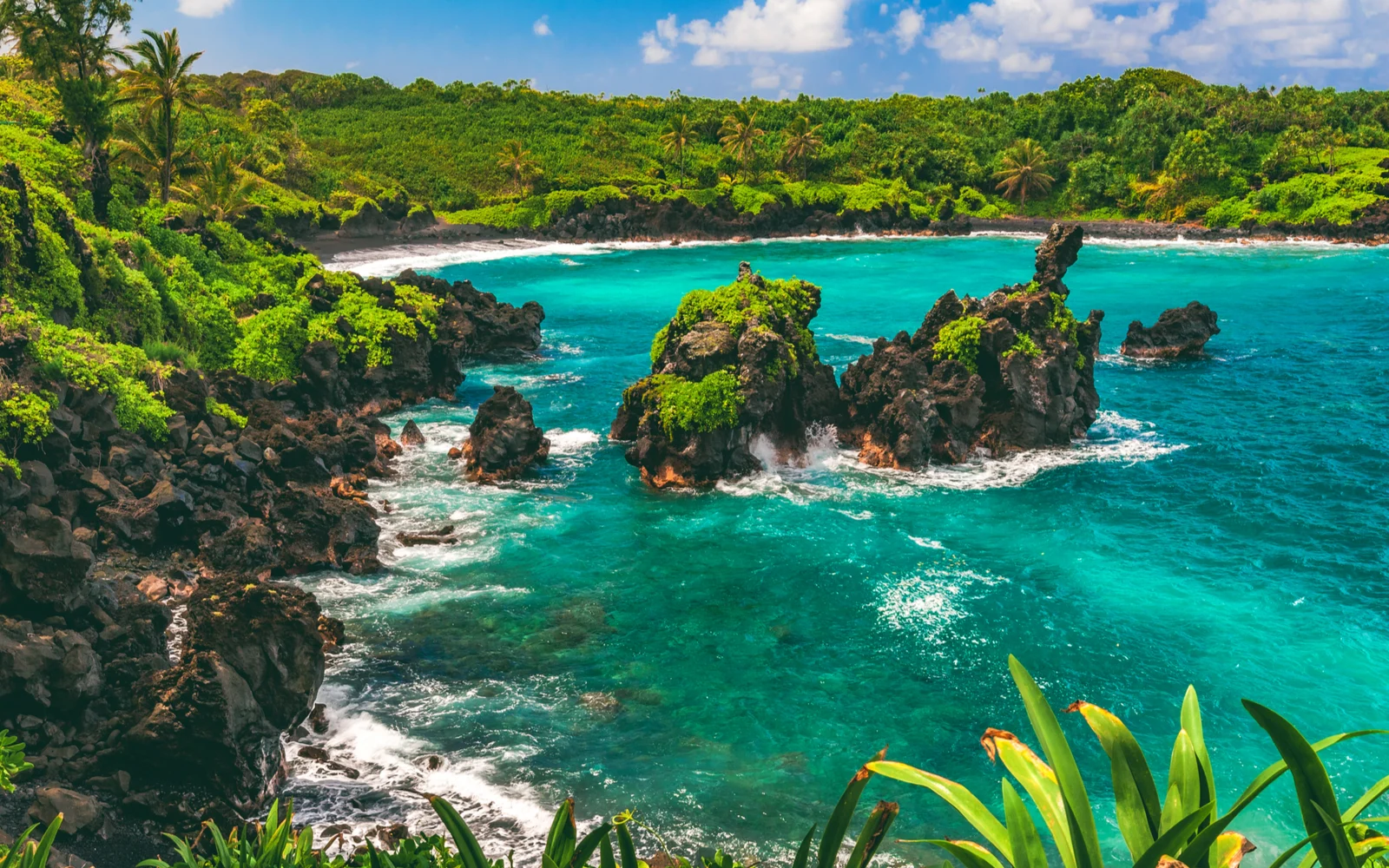Maui is called the Valley Isle and is one of the more popular Hawaiian islands to visit. It’s the second largest Hawaiian island and is absolutely loaded with the lush, tropical greenery and scenery that Hawaii is so famous for.
If you’re after a once-in-a-lifetime Hawaiian adventure, Maui is the island to visit. When you visit Maui, it’s like taking a trip to another (beautiful) planet. It’s home to some of the world’s most famous black and red sand beaches.
You can watch giant, migrating humpback whales from the shore during the “winter” months. The towering Haleakala Volcano on Maui is the island’s highest point and a favorite sight for visitors to marvel at.
Scenic highways wind through the island, making it easy to tour on wheels. In Maui’s Ohe’o Gulch and Waianapanapa State Park, you’ll find those famous red and black sand beaches, sparkling natural pools, cascading waterfalls, and sprawling shores to relax on.
Or if fast-paced fun is more your speed, try zip lining through the rainforest, windsurfing on the beach, hop over to the nearby Molokini islet via ferry, or spend an afternoon snorkeling and checking out the ocean life.
But while there’s plenty to see and do, what’s the best time to visit Maui? Here’s our take.
The Best Time to Visit Maui in 2025
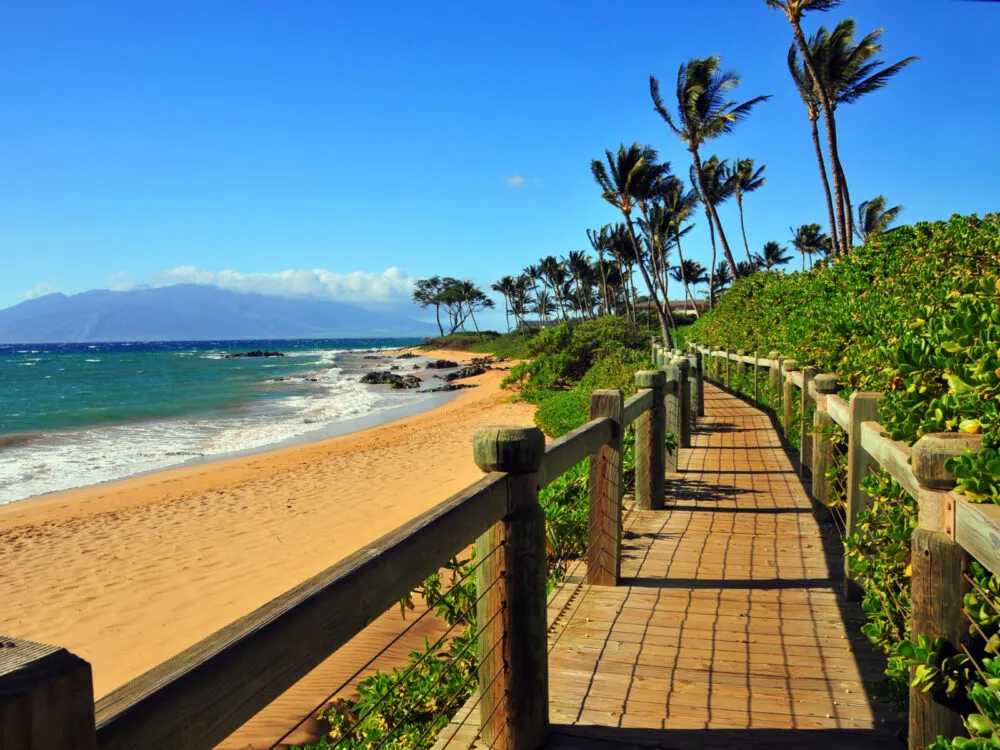
Mike Brake/Shutterstock
The best time to visit Maui is between May and August. While anytime is technically a good time to visit, the weather, your budget, and crowds are all best during the summer.
Summertime festivals and cultural activities (luaus, evening shows, etc.) are in full swing so you can get a taste of true Hawaiian culture. This popular period offers ideal weather and little rainfall, so it’s perfect if you’re planning on a lot of outdoor plans and activities.
And on Maui, who isn’t?
If we had to choose the best single month to go to Maui, it’s May. Sweet smells fill the air as tropical plumeria, ginger, and hibiscus burst into bloom.
The major summer crowds haven’t arrived yet, so it’s a little less crowded but everything on the island is open in preparation for their arrival in June. In June, July, and August, it’s peak tourism season on Maui.
People arrive in droves because the weather is absolutely ideal this time of year (upper 80s and mostly sunny), the ocean is calmer (perfect for families with littles), and activities and tours are operating at max capacity.
You can run into limited hotel and resort availability during this time of year, but booking early can net you more options and cheaper prices.
Don't waste your hard-earned money. Get the best deal on your trip by comparing deals on Booking.com and Expedia!
- Options for all travel styles & budgets
- Price match guarantees
- Exclusive last-minute deals
Cheapest Time to Visit Maui
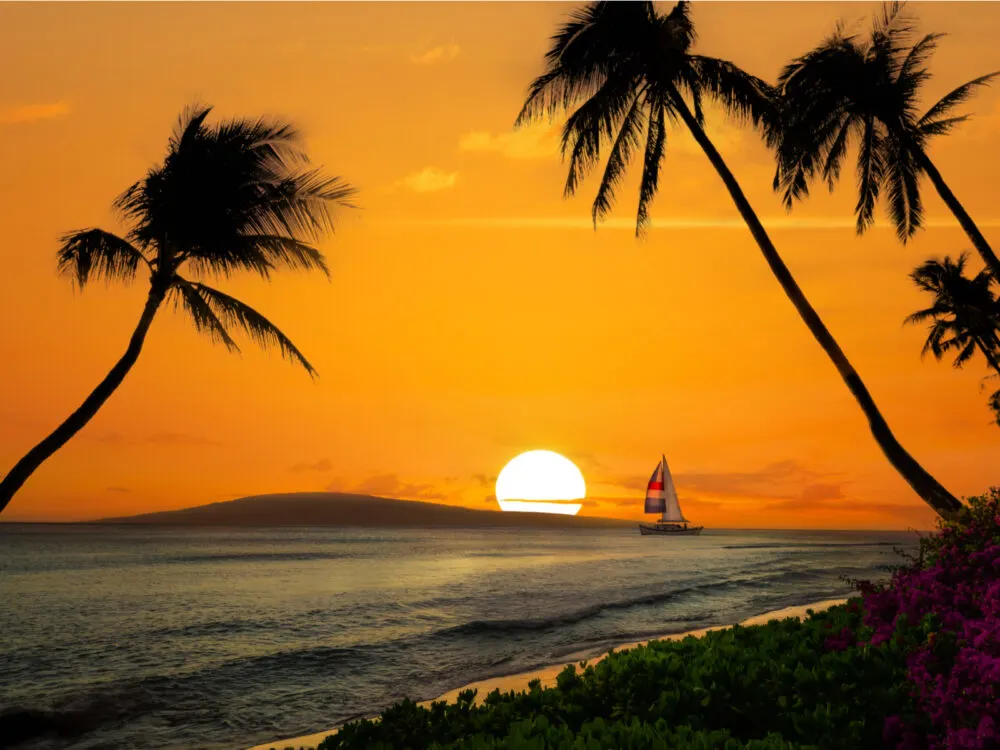
jdross75/Shutterstock
The cheapest time to visit Maui for cheaper prices on hotels and flights is during the shoulder seasons – the spring and fall. Most visitors arrive during summer and winter, and school breaks tend to mean major increases in tourists and prices.
Visiting during the months of February or September will give you the cheapest options for your stay. February is the tail end of the busy winter season, when snowbirds flock to Maui for a taste of warmth and greenery while the weather’s dreary and cold back home.
You can take advantage of discounted flights and hotel stays during February, and while Maui’s temperatures aren’t at their highest this time of year (hovering around 82 degrees), that’s likely ideal for most.
While February is pretty quiet, September is the least busy month to visit Maui overall. That means there’s less demand for flights and hotels, so you’ll benefit with deeply discounted prices that make your stay more affordable.
Lines are shorter, it’s still hot and sunny (around 90 degrees daily), and you’ll have shorter lines for attractions and tours.
Least Busy Time to Visit Maui
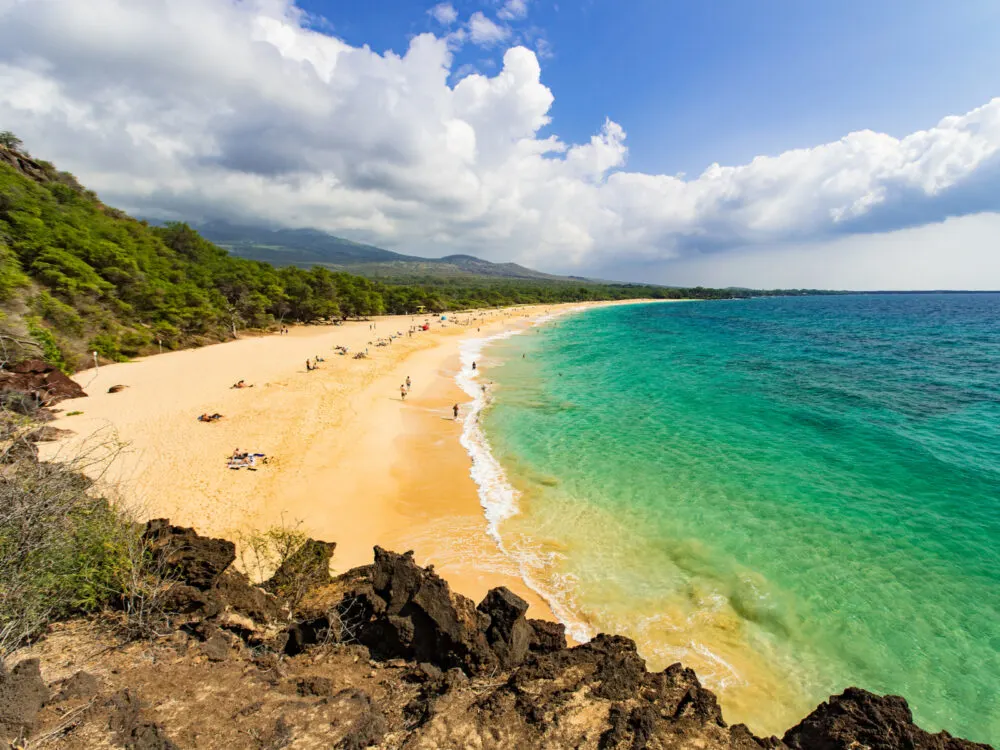
fotogestoeber/Shutterstock
The least busy time to visit Maui is between September and November. This is when the fewest visitors are arriving on the island, so there’s more options for flights, hotels, and resorts.
You’ll enjoy less-crowded beaches, pools, and shorter lines for activities. Prices are discounted during this low season because there’s less demand for Maui’s accommodations.
Don’t think that fall time means cool weather on Maui, though. Temperatures are still in the upper 80s and 90s at this time of year, so it’ll still feel like a tropical vacation.
This is about as hot as it gets on Maui, so make sure to stay hydrated and take breaks out of the sun to make the most of your fall stay. If you visit during September-November, you absolutely must drive the Road to Hana.
With fewer tourists on the road, you’ll have better views of this incredible, scenic route. Traffic is nonexistent during this time and you can take your time along the route to fully enjoy the scenery.
Worst Time to Visit Maui
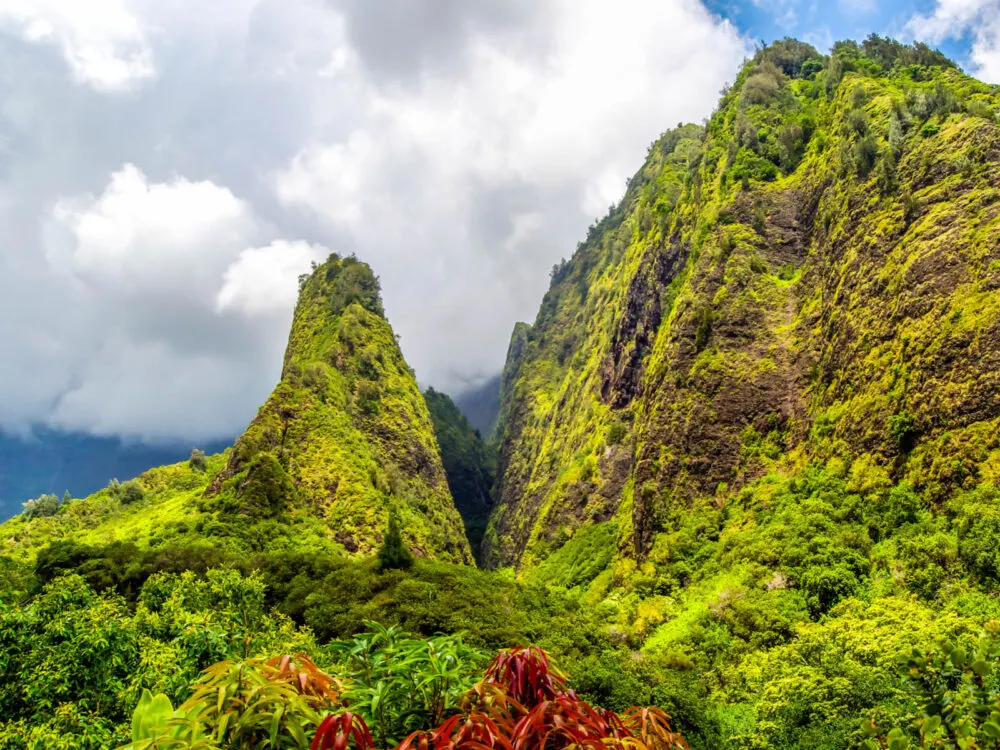
MH Anderson Photography/Shutterstock
The worst time to visit Maui is between December and March. But it really depends on what your goals for the trip are. The winter season sees major spikes in tourists visiting to escape the cold, miserable winters in colder areas.
As a result, you’ll pay higher prices and deal with larger crowds when you visit at this time of year. If you must go at this time of year, go in February.
There’s a short dip in visitors and prices during February in between the holidays and Spring Break. While there’s a big uptick in visitors from December to March, it’s really nothing compared to the summer swell (June through August) – this is the actual peak season on Maui.
But the warmer weather, calmer waters, and better activity options still make it a better time to go than December through March.
Maui by Month: Climate & Activities
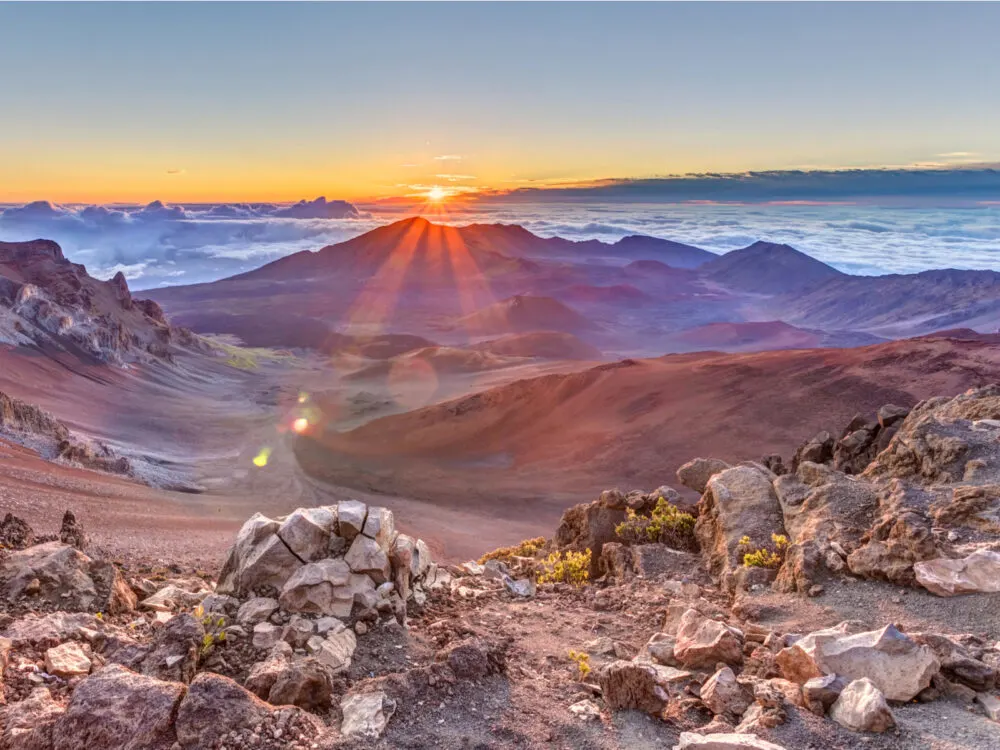
Pierre Leclerc/Shutterstock
Still unsure about the best time to visit Maui? Take a look at our summary of the weather and climate by month below:
January
Winter temperatures in Maui range from 18 to 28°C (64-82°F). It’s an ideal time for whale watching, exploring the Road to Hana, and enjoying the beaches with lower crowds.
February
Similar to January, February maintains mild temperatures between 18 to 28°C (64-82°F). Visitors can experience the beauty of the Iao Valley and go snorkeling in Molokini Crater.
March
As spring begins, temperatures range from 18 to 28°C (64-82°F). March is perfect for hiking in Haleakalā National Park, enjoying the Maui Whale Festival, and exploring the local coffee plantations.
April
Spring temperatures in Maui range from 19 to 29°C (66-84°F). It’s an ideal time for attending the East Maui Taro Festival, exploring the beaches of Wailea, and taking helicopter tours over the island.
May
May sees temperatures ranging from 20 to 30°C (68-86°F). It’s a great month for surfing on the North Shore, experiencing the scenic beauty of the Hana Highway, and enjoying water activities in Kihei.
June
Summer arrives with temperatures between 21 to 31°C (70-88°F). June offers opportunities for snorkeling in Honolua Bay, hiking the Waihee Ridge Trail, and enjoying cultural events like the Kapalua Wine and Food Festival.
July
July maintains warm temperatures from 22 to 32°C (72-90°F). It’s a popular month for exploring the Haleakalā Crater, attending the Makawao Rodeo, and enjoying water sports in Kaanapali.
August
Temperatures on Maui in August range from 22 to 32°C (72-90°F). Despite the heat, it’s an excellent time for exploring the Upcountry, attending the Maui Onion Festival, and enjoying the beaches in Makena.
September
As fall begins, temperatures range from 22 to 32°C (72-90°F). September offers a pleasant transition, with opportunities for snorkeling in Molokini Crater, hiking in the Iao Valley, and enjoying local cuisine.
October
In October, Maui sees temperatures ranging from 21 to 31°C (70-88°F). It’s a great month for exploring the historic whaling town of Lahaina, attending the Maui Fair, and enjoying the beaches of Wailea.
November
Fall temperatures range from 20 to 30°C (68-86°F). November is perfect for whale watching, hiking the Pipiwai Trail in Hana, and attending cultural events like the Maui Film Festival.
December
In December, winter returns to Maui with temperatures ranging from 19 to 29°C (66-84°F). December brings opportunities for holiday celebrations, enjoying the beaches of Kaanapali, and participating in water activities in the Pacific Ocean.
Things to Consider
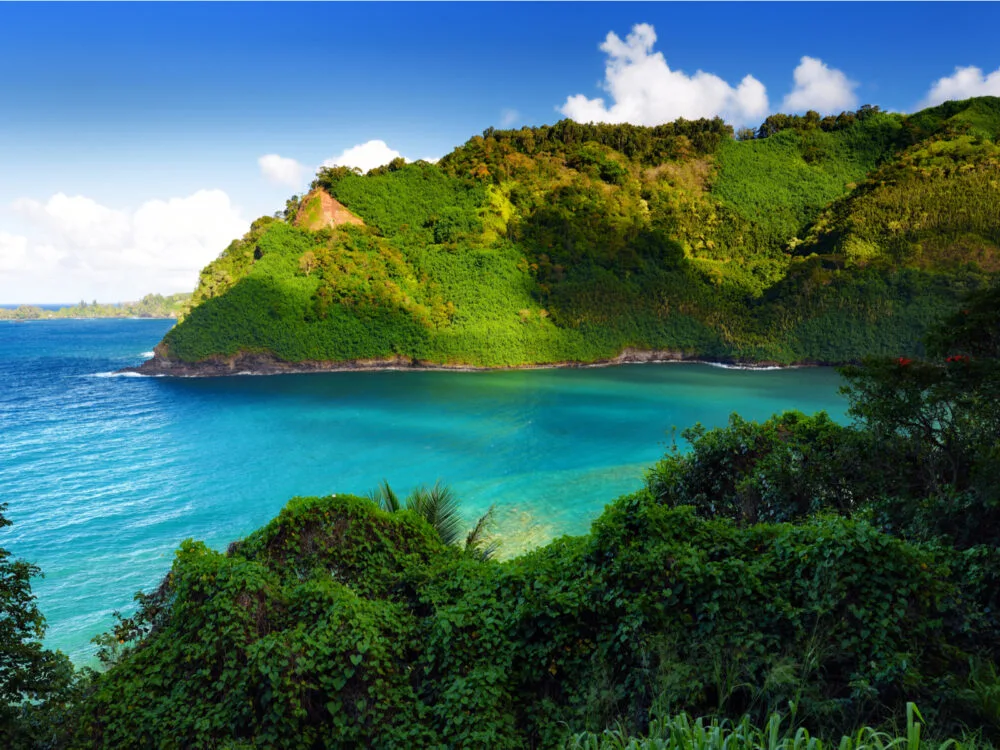
MNStudio/Shutterstock
Now that you know the best time to visit Maui, what else should you keep in mind to have the best getaway possible? We’ve got a few travel tips for you. Making the most of your Maui vacation starts here!
- Winter is best for surfing and whale watching. The Pacific Ocean’s waters are too calm for catching a wave on Maui’s shores during the spring and summer. You’ll find the best conditions for surfing during the winter months from December to early March – especially on Hookipa Beach. This is also when humpback whales migrate through the area, so keep your eyes open to witness something incredible!
- Summer is best for families. If you’re traveling with the whole clan in tow, Maui is best in the summertime (June through August). The waters are calmer and more conducive to a relaxing swim and snorkeling. You can confidently bring your kids to the water without worrying about intense currents and rough waters during the summer. There are also tons of outdoor activities and tours the whole family can enjoy!
- Spring and fall are best for low prices and smaller crowds. Spring and fall are Maui’s shoulder seasons, when tourism takes a dip and prices follow suit. Fall is warmer than spring and typically has the least visitors and cheapest prices, so if those are important factors in your trip, plan to visit in September or November.
- Pack the proper gear. On Maui, there’s a lot to see and explore, so make sure you’ve got everything you need to make the most of it. You’ll want to pack comfortable sandals and tennis shoes, lightweight clothing, lots of sunscreen, bug spray, and sunglasses. If you plan to explore east Maui’s rainforests while you’re there, pack a pair of lightweight pants and a breathable long sleeve shirt. Bring a pair of binoculars if you plan to spot wildlife and ocean life (including dolphins and migratory humpback whales)!
- Use ferries to easily island hop. There are multiple daily ferry expeditions to carry visitors from Maui to nearby islands and islets of Lanai and Molokai. Take advantage of this service and take a day trip to see more of Hawaii’s unique landscapes – you’ll be so glad you did.
- Choose the best place to stay. On Maui, you’ll have tons of options for hotels and resorts. It can be a little overwhelming to choose without knowing firsthand what each one is really like.
Don't waste your hard-earned money. Get the best deal on your trip by comparing deals on Booking.com and Expedia!
- Options for all travel styles & budgets
- Price match guarantees
- Exclusive last-minute deals
So, What Is the Best Time to Visit Maui?
The overall best time to visit Maui is May through August, with May being the absolute best choice. It’s just before the full summer high season hits, so you’ll benefit with a slight dip in prices and smaller crowds.
If you go during June, July, or August, you won’t be bothered by the larger crowds and higher prices – this is when Maui is at its peak, with the best weather, most options for activities, and least rainfall.
So, with so much to see and do, what are you waiting for — book your trip today and experience for yourself all that Maui has to offer. Happy travels!



